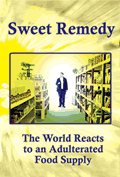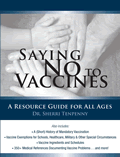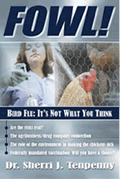UNHEALTHY BRAINS AND TEENAGE VIOLENCE
Dr. Sherri Tenpenny, DO
March 2, 2011
NewsWithViews.com
It’s been nearly two months since the nation's attention was focused on Tucson, where five were killed and 13, including Congresswoman Gabrielle Giffords. During that same period, several other shootings were missed by the mainstream news. Violence seems to be erupting among youths everywhere, from Los Angeles[1] to Omaha[2] to Brooklyn[3] - indicating something is seriously going wrong in the minds of young persons in this country.
Why Young Brains Are Unwell
The list of assailing particles on children is long, and starts with chemical exposure in the womb. In July, 2005, the Environmental Working Group released a hallmark study using cord blood to assess the chemical exposure of neonates in-utero. The placenta has long been thought to shield the developing baby from pollutants in the environment. The study's alarming results dispelled this as a wishful myth. Of the 287 chemicals identified in the umbilical cord blood of 10 infants, 180 were known carcinogens, 217 were toxic to the brain and nervous system, and 208 have been associated with birth defects or abnormal development in animal tests. The study concluded that, "the dangers of pre- or post-natal exposure to this complex mixture of carcinogens, developmental toxins and neurotoxins have never been studied."[4]
Within hours of emerging from the womb, a newborn is given a dollop of antibiotics in the eyes, injected with the hepatitis b vaccine, with knonwn neurotoxic properties,[5] and jabbed with a vitamin K shot, which contains 9 mg of benzyl alcohol. In 1992, Golding published concerns that vitamin K injections could be associated with a doubled risk of malignant disease in children, particularly leukemia. While there have been considerable doubts about whether the association is coincidental or causal, the controversy has never been completely resolved.[6]
Starting around the 60th day of life, infants with still immature immune systems are subjected to a battery of vaccines: DTaP, HiB, polio, Prevnar, and a squirt of oral rotavirus vaccine, all generally given at the same time. The onslaught of these shots, including two additional injections of hepatitis b vaccine, repeats twice, every 60 days. This deposits approximately 66 different viral or bacterial antigens and measurable amounts of a dozen different chemicals into a six month old infant. By the time a child is five years old, a little 40 pound human will receive up to 35 injections, containing at least 110 different weakened pathogens (or pathogen particles), and an assortment of 59 different chemicals. If all approved shots are administered, the little tot will also be injected with stray viral DNA, four types of animal cells, cells from aborted fetal tissue and a bit of human albumin (a foreign protein.) By the way, all of these substances are listed on package inserts for each vaccine.
Subjective Labels for Brain Pathology
According to the U.S. Surgeon General, nearly 20 percent of American children and adolescents suffer from a mental disorder so significant, it interferes with their day-to-day life.[7] The plethora of diagnoses fall into a few fairly well defined categories: Conduct disorders, such as attention-deficit hyperactivity disorder (ADHD); learning disabilities, a spectrum of speech delay and comprehension issues; and mood disorders, which include depression, bipolar disorder and chronic anxiety.
The Centers for Disease Control (CDC) approximates that nearly 5.4 million children 4 to 17 years of age have been diagnosed with ADHD alone (2007 data). This represents nearly 1 in 10 of all children - and the number has been escalating. Between 2003 and 2007, the number of parent-reported children diagnosed with ADHD increased by 22 percent.[8] Disturbingly, in an attempt to quell their out-of-control behavior, more than two thirds of these children have been placed on at least one prescription medication. Since the underlying cause for the sick brain and hyperkinetic behavior has not been identified and addressed, the drugging is akin to tightening down the lid on a boiling pot of water.
One of these behavioral disorders, called Oppositional Defiant Disorder (ODD)[9] is said to manifest around 8 years of age. Mannerisms include: easily losing one's temper; aggressively arguing with adults and defying requests; refusing to follow rules; deliberately annoying other people; blaming others for one's own mistakes or misbehavior; and being touchy, easily annoyed or angered, resentful, spiteful, or vindictive. In 2008, ODD was the most common reason children were referred to mental health professionals for an assessment, accounting for at least half of all out patient visits to psychiatrists and psychiatric practitioners. These children, mostly boys, are commonly diagnosed and treated for several coexisting mental disorders.[10]
The fifth edition of the Diagnostic and Statistical Manual of Mental Disorders (DSM-V) is about to be released, replacing the older DSM-IV. The DSM[11] is a catalog of hundreds of psychiatric conditions, including a long list of anxiety, personality and adjustment disorders. Diagnoses are available to give children who struggle with math and writing skills a diagnosis (Mathematics Disorder 315.1 and Disorder of Written Expression 315.2, respectively), labeling a child who has a missing skill with a mental deficiency. New disorders are on the horizon too, such as Temper Dysregulation Disorder with Dysphoris (TDD),[12] a tweak to the current diagnosis of bipolar disorders for children under the age of 10.
Treatments
offered for malfunctioning, unhealthy brains include an extensive
list of prescription medications, divided by class, based on the effect
they are thought to have on brain chemistry.
Antidepressants, mood stabilizers, anti-psychotics and sedatives are
prescribed to ostensibly correct imbalances in brain chemicals. If
one drug doesn't work, more are added, perhaps with unintended consequences
on behavior.
A recent 69-month study identified 484 drugs that accounted for 780,169 serious adverse events, including violence and aggressive behavior. The drugs were associated with 387 reports of homicide, 404 physical assaults, 27 cases indicating physical abuse, 896 homicidal ideation reports, and 223 cases described as violence-related symptoms. Medications most strongly associated with violence[13] were 11 different antidepressants, such as Lexapro, Paxil, and Zoloft; 6 different medications for anxiety (ex: Xanax and Clonipin) and 3 drugs given for ADHD, including Ritalin and Concerta. Additionally, the drugs Seroquel, Zyprexa and Respirdol, commonly used to treat ODD,[14] are among drugs that can lead to violence.
Combined Effects
Significant populations of children in the U.S. have been exposed to a combination of chemicals, vaccines and multiple prescription medications - from infancy through early adulthood. No studies have examined the effect these components have individually on brain function, let alone in combination. Mental health experts try to convince us that the chemical exposures are so small they cannot have negative effects. Same with vaccines. "Experts" espouse that vaccinations are safe, effective, protective and harmless. No thought -- or research -- has been done to examine the potential problems that can arise from the combined effect of four or more simultaneous medications, vaccines and chemicals. There has been little effort by the government (FDA/CDC), the pharmaceutical industry or doctors -- all of whom profit handsomely from massive drug and vaccine use --- to evaluate the combined negative effects of these exposures.
Brain inflammation has been the hallmark of severe reactions since the first vaccine -- smallpox. The pertussis vaccination can have profound effects on the developing brain of a child, leading to permanent changes in behavior, personality, intelligence, emotional stability, and physical ability. Virtually every year--from 1933 to the mid-1980s-- a paper was published discussing the adverse effects of the whole cell pertussis vaccine.[15] Instead of spending more money to create new drugs and vaccines, we should demand that industry and governments study the complications and injuries caused by the combined use of the products we already have.
Violence In America
I have received many emails and messages over the years from persons or parents who are planning to go to other countries for a vacation, on a mission trip or to participate in a lifestyle immersion event. While many of the questions are about travel vaccines (few of which are required anywhere in the world; they are only recommended), I also get asked, "Do you think it is safe to go there?"
That question always makes me pause. I've had the good fortune to have traveled throughout 57 countries over my life. Only on rare occasions- and mostly when I was in an ill-advised part of town or was unaccompanied in a rural area with wild animals I was unfamiliar with - did I ever feel unsafe. In fact, as a general rule, I have felt safer off the beaten path in a foreign country than in the downtown of an unknown, mid-sized city after dark anywhere in the U.S.
An epidemic of chronic physical illness, mental disability, depression and violent behavior have escalated over the last 20 years and in one way or another, is touching us all. Although economic and social factors, biological variables and individual dietary practices certainly play a role in overall health and behavior, the detrimental, combined effect of chemicals, drugs and vaccines heaped into the brain from birth is a real concern and is undoubtedly a huge contributor to the violence rising among America's youths.
Based on survey data[16] from the U.S. Department of Justice, roughly 5,340,000 violent crimes were committed in the United States during 2008. This includes almost 16,300 murders of which, 76 percent, or nearly 11,000 incidents, were committed with firearms. Since the Tucson shootings, calls for stricter licensing and gun registration, more vigorous background checks prior to purchasing a gun, and a ban on assault weapons are again on the table. The pros and cons of this debate reach far beyond the scope of this discussion.
| Subscribe to the NewsWithViews Daily News Alerts! |
But truly, guns don't shoot people. And something obviously makes people shoot people. Perhaps stopping the chain of events that result in medically unhealthy and physically sick young brains is the place to start. We owe it to future generations to clearly identify the effect these combined toxic compounds are having on brains of all ages. Even more importantly, we need to heal these damaged brains and restore them back to health before the epidemic of violence gets any worse.
First posted on NaturalNews.com
Footnotes:
1,
Los
Angeles shooting
2,
Omaha
shooting.
3,
Brooklyn
shooting.
4,
EWG
study on chemicals.
5,
Hepatitis
B hazards
6,
Vitamin
K controversy.
7,
Mental
illness in children.
8,
CDC,
Parent-reported ADHD
9.
eMedicine,
Oppositional Defiant Disorder.
10.
Facts
for Families, ODD
11.
Complete
list of Mental Disorders.
12.
The
new Temper Disorder.
13,
Medications
associated with violence.
14,
Medications
to treat ODD, ADHD, etc.
15,
True
story of pertussis.
16,
JustFacts.com
re: crime and self defense.
� 2011 - Sherri Tenpenny - All Rights Reserve
Sign
Up For Free E-Mail Alerts
E-Mails are used strictly for NWVs
alerts, not for sale
Dr.
Sherri J. Tenpenny is a board-certified osteopathic medical doctor.
She is widely regarded as one of the country’s most knowledgeable
and outspoken physicians on the negative impact vaccines can have
on health. In addition to concerns about childhood vaccinations, her
book, Saying No to Vaccines, addresses vaccination issues facing adults,
international travelers, healthcare workers, nursing home residents,
adoptions, college students, and those in the military. Dr. Tenpenny
is a regular columnist for NewsWithViews.com.
Her books, "Saying No to Vaccines" and FOWL! are available
through this site. Other tapes and materials are available www.DrTenpenny.com.
To learn about her medical clinic at www.TenpennyIMC.com
In addition to vaccines, Dr Tenpenny is an expert on many topics within
the field of Integrative Medicine. She speaks frequently on breast
health, women's health, natural approaches to thyroid and adrenal
conditions. She is a contributing author to the best-selling book,
"Vaccine Epidemic: How Corporate Greed, Biased Science, and Coersive
Government Threaten Our Human Rights, Our Health and Our Children."
Website: www.DrTenpenny.com
Website: www.TenpennyIMC.com
Website: www.SayingNoToVaccines.com
E-Mail: drtenpenny@gmail.com











 Share
This Article
Share
This Article




